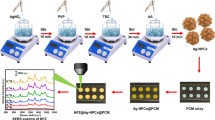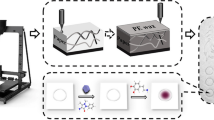Abstract
A highly stable electrochemical biosensor for pesticide detection was developed. For the first time polymeric ionic liquids (PILs) were introduced to construct an acetylcholinesterase (AChE) biosensor . AChE was entrapped in PILs microspheres through an emulsion polymerization reaction, where negatively charged Au nanoparticles (Au NPs) can be immobilized by the positively charged PILs, leading to improved catalytic performance. The results suggest that the positively charged PILs not only provide a biocompatible microenvironment around the enzyme molecule, stabilizing its biological activity and preventing its leakage, but also act as a modifiable interface allowing other components with electron transport properties to be loaded onto the polymer substrate, thus providing an efficient electron transport channel for the entrapped enzyme. More notably, when AChE was immobilized in a positively charged environment, the active site is closer to the electrode, promoting faster electron transfer. The detection limits of the constructed electrochemical biosensor AChE@PILs@Au NPs/GCE toward carbaryl and dichlorvos (DDVP) were 5.0 × 10−2 ng ml−1 and 3.9 × 10−2 ng ml−1, in a wide linear range of 6.3 × 10−2–8.8 × 102 ng ml−1 and 1.3 × 10−1–1.4 × 103 ng ml−1, respectively. More importantly, the biosensor has high thermal and storage stability, which facilitates rapid field analysis of fruits and vegetables in a variety of climates. In addition, the biosensor reported has good repeatability and selectivity and has high accuracy in the analysis of peaches, tap water, and other types of samples.
Graphical abstract







Similar content being viewed by others
References
Sharma P, Pandey V, Sharma MMM et al (2021) A review on biosensors and nanosensors application in agroecosystems. Nanoscale Res Lett 16:136. https://doi.org/10.1186/s11671-021-03593-0
Khanmohammadi A, Jalili Ghazizadeh A, Hashemi P et al (2020) An overview to electrochemical biosensors and sensors for the detection of environmental contaminants. J Iran Chem Soc 17:2429–2447. https://doi.org/10.1007/s13738-020-01940-z
Pajooheshpour N, Rezaei M, Hajian A et al (2018) Protein templated Au-Pt nanoclusters-graphene nanoribbons as a high performance sensing layer for the electrochemical determination of diazinon. Sensor Actuat B-Chem 275:180–189. https://doi.org/10.1016/j.snb.2018.08.014
Pundir CS, Malik A, Preety, (2019) Bio-sensing of organophosphorus pesticides: a review. Biosens Bioelectron 140:111348. https://doi.org/10.1016/j.bios.2019.111348
Zhao HY, Ma HN, Li XG et al (2021) Nanocomposite of halloysite nanotubes/multi-walled carbon nanotubes for methyl parathion electrochemical sensor application. Appl Clay Sci 200:105907. https://doi.org/10.1016/j.clay.2020.105907
Loguercio LF, Thesing A, Demingos P et al (2021) Efficient AChE immobilization for improved electrochemical performance in polypyrrole nanocomposite-based biosensors for carbaryl pesticide. Sens Actuators B Chem 339:129875. https://doi.org/10.1016/j.snb.2021.129875
Liu XF, Wu ZX, Yang XH et al (2020) Photothermal and fluorescent dual-mode assay based on the formation of polydopamine nanoparticles for accurate determination of organophosphate pesticides. Microchim Acta 187:652. https://doi.org/10.1007/s00604-020-04629-5
Cao J, Wang M, Yu H et al (2020) An overview on the mechanisms and applications of enzyme inhibition-based methods for determination of organophosphate and carbamate pesticides. J Agric Food Chem 68:7298–7315. https://doi.org/10.1021/acs.jafc.0c01962
Lee CH, Jin ES, Lee JH et al (2020) Immobilization and stabilization of enzyme in biomineralized calcium carbonate microspheres. Front Bioeng Biotech 8:553591. https://doi.org/10.3389/fbioe.2020.553591
López Sánchez-Paniagua M, Mecerreyes D, López-Cabarcos E, López-Ruiz B (2006) Amperometric glucose biosensor based on polymerized ionic liquid microparticles. Biosens Bioelectron 21:2320–2328. https://doi.org/10.1016/j.bios.2006.02.019
Radulescu MC, Bucur MP, Bucur B et al (2019) Ester flavorants detection in foods with a bienzymatic biosensor based on a stable Prussian blue-copper electrodeposited on carbon paper electrode. Talanta 199:541–546. https://doi.org/10.1016/j.talanta.2019.02.094
Bagheri H, Ranjbari E, Amiri-Aref M et al (2016) Modified fractal iron oxide magnetic nanostructure: a novel and high performance platform for redox protein immobilization, direct electrochemistry and bioelectrocatalysis application. Biosens Bioelectron 85:814–821. https://doi.org/10.1016/j.bios.2016.05.097
Gao SS, Liu J, Luo J et al (2018) Selective voltammetric determination of Cd(II) by using N, S-codoped porous carbon nanofibers. Microchim Acta 185:1–9. https://doi.org/10.1007/s00604-018-2818-2
Lebedeva O, Kultin D, Kustov L (2021) Electrochemical synthesis of unique nanomaterials in ionic liquids. Nanomaterials 11:3270. https://doi.org/10.3390/nano11123270
Karpenko A, Leppelt R, Cai J et al (2007) Deactivation of a Au/CeO2 catalyst during the low-temperature water-gas shift reaction and its reactivation: a combined TEM, XRD, XPS, DRIFTS, and activity study. J Catal 250:139–150. https://doi.org/10.1016/j.jcat.2007.05.016
Singh S, Tripathi P, Kumar N et al (2016) Colorimetric sensing of malathion using palladium-gold bimetallic nanozyme. Biosens Bioelectron 92:280–286. https://doi.org/10.1016/j.bios.2016.11.011
Uosaki K, Shen Y, Kondo T (1995) Preparation of a highly ordered Au (111) phase on a polycrystalline gold substrate by vacuum deposition and its characterization by XRD, GISXRD, STM/AFM, and electrochemical measurements. J Phys Chem 99:14117–14122. https://doi.org/10.1021/j100038a051
Aslanian D, Grof P, Bon S et al (1991) A comparative Raman spectroscopic study of cholinesterases. Biochimie 73:1375–1386. https://doi.org/10.1016/0300-9084(91)90167-Y
Cui HF, Wu WW, Li MM et al (2018) A highly stable AChE biosensor based on chitosan-TiO2-graphene nanocomposites for detection of organophosphate pesticides. Biosens Bioelectron 99:223–229. https://doi.org/10.1016/j.bios.2017.07.068
Cui HF, Zhang TT, Lv QY et al (2019) An AChE biosensor based on doping Au nanorod@SiO2 nanoparticles into TiO2-chitosan hydrogel for detection of organophosphate pesticides. Biosens Bioelectron 141:111452. https://doi.org/10.1016/j.bios.2019.111452
Mahmoudi E, Fakhri H, Hajian A et al (2019) High-performance electrochemical enzyme sensor for organophosphate pesticide detection using modified metal-organic framework sensing platforms. Bioelectrochemistry 130:107348. https://doi.org/10.1016/j.bioelechem.2019.107348
Su DD, Zhao X, Yan X et al (2021) Background-free sensing platform for on-site detection of carbamate pesticide through upconversion nanoparticles-based hydrogel suit. Biosens Bioelectron 194:113598. https://doi.org/10.1016/j.bios.2021.113598
Shamagsumova RV, Shurpik DN, Padnya PL et al (2015) Acetylcholinesterase biosensor for inhibitor measurements based on glassy carbon electrode modified with carbon black and pillar[5]arene. Talanta 144:559–568. https://doi.org/10.1016/j.talanta.2015.07.008
Ha TB, Le HT, Cao HH (2018) Electro-immobilization of acetylcholinesterase using polydopamine for carbaryl microsensor. J Electron Mater 47:1686–1693. https://doi.org/10.1007/s11664-017-5880-3
Wong FCM, Ahmad M, Heng LY et al (2006) An optical biosensor for dichlovos using stacked sol-gel films containing acetylcholinesterase and a lipophilic chromoionophore. Talanta 69:888–893. https://doi.org/10.1016/j.talanta.2005.11.034
Shi MH, Xu JJ, Zhang S et al (2006) A mediator-free screen-printed amperometric biosensor for screening of organophosphorus pesticides with flow-injection analysis (FIA) system. Talanta 68:1089–1095. https://doi.org/10.1016/j.talanta.2005.07.007
Tutunaru O, Mihailescu CM, Savin M et al (2016) Acetylcholinesterase entrapment onto carboxyl-modified single-walled carbon nanotubes and poly (3,4-ethylenedioxythiophene) nanocomposite, film electrosynthesis characterization, and sensor application for dichlorvos detection in apple juice. Microchem J 169:106573. https://doi.org/10.1016/j.microc.2021.106573
Li YP, Zhao RX, Shi LY et al (2017) Acetylcholinesterase biosensor based on electrochemically inducing 3D graphene oxide network/multi-walled carbon nanotube composites for detection of pesticides. RSC Adv 7:53570–53577. https://doi.org/10.1039/c7ra08226f
Li YP, Shi LY, Han GY et al (2017) Electrochemical biosensing of carbaryl based on acetylcholinesterase immobilized onto electrochemically inducing porous graphene oxide network. Sens Actuators B Chem 238:945–953. https://doi.org/10.1016/j.snb.2016.07.152
Mashuni M, Ritonga H, Jahiding M et al (2022) Highly sensitive detection of carbaryl pesticides using potentiometric biosensor with nanocomposite Ag/r-graphene oxide/chitosan immobilized acetylcholinesterase enzyme. Chemosensors 10:138. https://doi.org/10.3390/chemosensors10040138
Wu S, Huang FF, Lan XQ et al (2012) Electrochemically reduced graphene oxide and Nafion nanocomposite for ultralow potential detection of organophosphate pesticide. Sens Actuators B Chem 177:724–729. https://doi.org/10.1016/j.snb.2012.11.069
Sun X, Wang XY (2010) Acetylcholinesterase biosensor based on Prussian blue-modified electrode for detecting organophosphorous pesticides. Biosens Bioelectron 25:2611–2614. https://doi.org/10.1016/j.bios.2010.04.028
Wei M, Wang JJ (2015) A novel acetylcholinesterase biosensor based on ionic liquids-Au NPs-porous carbon composite matrix for detection of organophosphate pesticides. Sens Actuators B Chem 211:290–296. https://doi.org/10.1016/j.snb.2015.01.112
Liu Y, Wang MJ, Li J et al (2005) Highly active horseradish peroxidase immobilized in 1-butyl-3-methylimidazolium tetrafluoroborate room-temperature ionic liquid based sol-gel host materials. Chem Commun 1778–1780.
Edwards JA, Brimijoin S (1983) Thermal inactivation of the molecular forms of acetylcholinesterase and butyrylcholinesterase. Biochim Biophys Acta 742:509–516. https://doi.org/10.1016/0167-4838(83)90268-6
Acknowledgements
Authors Yu Wan, Huiting Wang Yaxian Chen, Shun Li, Jie Zhou, and Lixin Xia* received funding from the National Natural Science Foundation of China (21671089), the Liaoning Revitalization Talents Program (XLYC2002097), the Scientific Research Fund of Liaoning Provincial Education Department (L2020002), and the Liaoning Provincial Natural Science Foundation (2020-YKLH-22). Authors Yu Wan, Huiting Wang, Ling Zhang, Yaxian Chen, Shun Li, Jie Zhou, and Qian Zhang* received funding from the Scientific Research Fund of Liaoning Provincial Education Department (LR2019029).
Author information
Authors and Affiliations
Contributions
The manuscript was written through the contributions of all authors. All authors have given approval to the final version of the manuscript.
Corresponding authors
Ethics declarations
Competing interests
The authors declare no competing interests.
Additional information
Publisher's Note
Springer Nature remains neutral with regard to jurisdictional claims in published maps and institutional affiliations.
Supplementary Information
Below is the link to the electronic supplementary material.
Rights and permissions
About this article
Cite this article
Wan, Y., Wang, H., Zhang, L. et al. Highly stable acetylcholinesterase electrochemical biosensor based on polymerized ionic liquids microgel for pesticides detection. Microchim Acta 189, 300 (2022). https://doi.org/10.1007/s00604-022-05383-6
Received:
Accepted:
Published:
DOI: https://doi.org/10.1007/s00604-022-05383-6




